Ultimate Guide to Purchasing Prime Rib Roast: Tips & Tricks
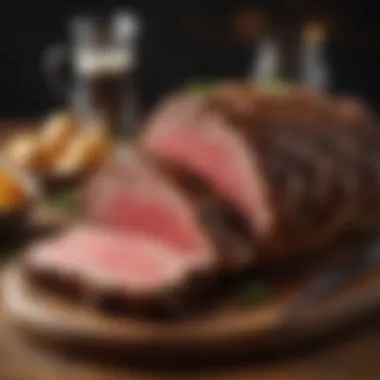
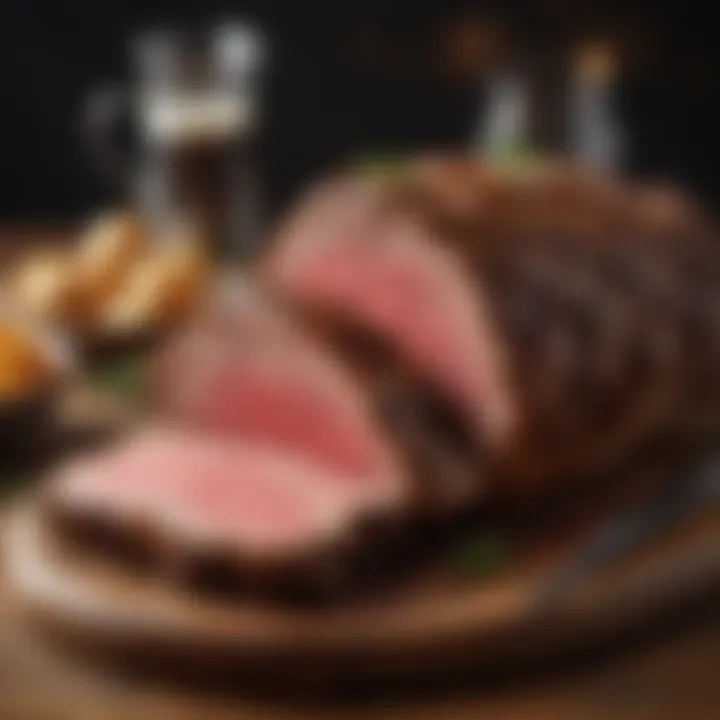
Intro
Buying a prime rib roast is a decision that can elevate a meal from ordinary to extraordinary. This cut of beef is renowned for its rich flavor and tenderness, making it a favorite among culinary enthusiasts. However, understanding how to select, purchase, and prepare a prime rib roast requires navigating through various factors. Throughout this guide, we will explore essential elements that will empower you to make informed choices, ensuring a rewarding culinary experience.
Throughout the sections, we will discuss criteria for selecting prime rib, where to source high-quality cuts, considerations regarding pricing, and delving into preparation methods that suit busy lifestyles. The aim is for you to grasp the nuances that contribute to a great roast, transforming a potentially overwhelming process into an enjoyable one.
Recipe Overview
- Spot On Prime Rib
- Portions: Serves 6 to 8
- Time Required: 20 minutes prep, 2 to 3 hours cooking
- Difficulty: Medium
Main Ingredients:
- Prime rib roast
- Kosher salt
- Freshly cracked black pepper
- Garlic cloves
- Fresh rosemary or thyme if desired
- Olive oil
Key Points Discussed
- Selection Criteria: Focus on marbling, size, and cut thickness.
- Sourcing Options: Choosing between local butchers, grocery stores, or online vendors.
- Pricing Considerations: Exploring pricing variance across different sources and regions.
- Preparation Methods: Methods to cook the prime rib effectively and efficiently.
Understanding these dimensions is not merely beneficial; it aligns with the discerning palate seeking to craft a memorable dining experience. Our subsequent parts will guide you seamlessly through this approach.
Understanding Prime Rib
Understanding prime rib is fundamental for anyone looking to purchase this celebrated cut of meat. Its substantial flavor and tenderness make it a preferred choice for a wide array of culinary occasions. This section will delve into essential elements that set prime rib apart and guide readers in making informed decisions.
Definition and Characteristics
Prime rib refers to a specific cut of beef from the upper ribs of the cow. It is known for its rich marbling, which contributes to its juiciness and flavor. The prime rib is typically aged, enhancing its tenderness and depth of taste. When cooked properly, prime rib can yield a remarkably tender and flavorful experience, rewarding the effort put into its selection and preparation.
Several characteristics mark high-quality prime rib. First, the marbling—a fatty intra-muscular pattern—indicates the flavor depth the meat will provide. Additionally, the muscle fiber of prime rib is less fibrous than cuts from other areas, offering a melt-in-your-mouth sensation once cooked. Overall, value comes not only from its taste but from the satisfaction that arises from serving a genuinely gourmet dish.
Different Cuts of Prime Rib
Prime rib can be broken down into several notable cuts, each with unique attributes. Grasping the differences can assist buyers in their selections and culinary aims.
Standing Rib Roast
The standing rib roast is perhaps the most well-known cut, boasting both visual appeal and flavor. This cut includes the entire rib section and is traditionally left standing on the bone during cooking. A key characteristic is its presentation; the bones create an appealing shape, enhancing the display at a gathering. It is a popular choice for celebratory meals due to its rich flavor profile and the tenderness associated with its preparation.
Unique Feature: Flavor and Tenderness
Attractively, the marrow and fat present on the ribbones contribute to a mild richness that elevates the roast's taste. However, one downside is the need for careful handling and cooking to preserve this cut's integrity.
Prime Rib Roast with Bone
This cut showcases the flavorful bone structure yet provides a slightly different texture than what is found in a boneless counterpart. Featuring high marbling, the prime rib roast with bone is commendable for imparting rich flavor during cooking. Infusing flavors from the bone elevates the meat’s potential for an exceptional culinary experience.
Unique Feature: Cooking Benefits
The advantage of this cut is the added moisture and flavor from the bone during the cooking process; however, it can require additional effort at the table when serving.
Boneless Prime Rib
Boneless prime rib offers a more convenient option, allowing easier slicing and serving. Many choose this cut for its simplicity and the clean visual it provides. The absence of bone makes it quite versatile for various cooking methods, including searing and braising.
Unique Feature: Convenience
A significant advantage includes its shorter cooking time and few serving complications. However, it may lack some flavor potency that the bone might imbue.
Appreciating the Value
Appreciating the value of prime rib goes beyond just understanding the cut itself; it includes recognizing its cost-effectiveness and culinary versatility. Prime rib can serve multiple people at once, making it suitable for family gatherings and special events. Proper selection ensures that customers receive excellent quality for the price, resulting in both satisfaction and memorable dining experiences. Access to high-quality beef combined with appropriate preparation elements amplifies the entire experience, crafting an elegant centerpiece that meets or exceeds expectations.
Choosing Quality Prime Rib
Choosing a quality prime rib is an essential part of the purchasing process. A well-chosen roast can reflect meticulous selection methods, guaranteeing a more enjoyable dining experience. This section emphasizes the critical factors that influence quality, ensuring that the final choice matches the consumer’s preferences and expectations.
Grading Standards
Grading standards play a significant role in determining the quality of prime rib. The United States Department of Agriculture (USDA) sets specific criteria thatcategorize beef based on its texture and marbling. This assurance can elevate the thoroughfare for culinary experiences to excellence.
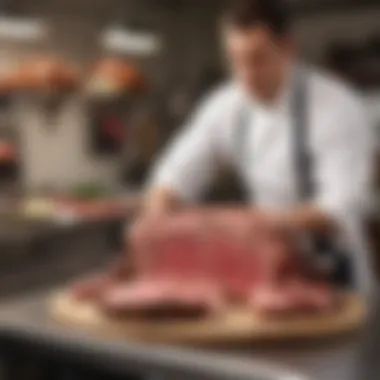

USDA Grades Explained
USDA grading classifies beef items into several categories: Prime, Choice, and Select. Among these, Prime is renowned for the highest amount of marbling. This characteristic enhances flavor and juiciness. From this perspective, consumers are likely to find USDA Prime as doling out premium choices for those seeking a special culinary occasion.
What sets USDA Prime apart is its unique blend of exceptional taste, tenderness, and quality assurance. However, such designation often comes with a considerable price tag. Understanding these grades allows individuals to select within their budget while maintaining desired flavor profiles.
How Grade Affects Taste and Tenderness
The grade of meat strongly influences its taste and tenderness. Higher grades usually correlate with more marbling, which results in a more flavorful profile and tender appreciations. Selection of a higher grade is advantageous when customers aim for an sophisticated roast offering optimal enjoyment.
Today's consumers benefit most when opting for higher grades not only because of flavor but due to established tenderness. Conversely, those choosing lower grades may experience variation in their dining satisfaction. The grade reflects the importance of maturing every bite thoughtfully.
Selecting the Right Size
Determining the appropriate size of prime rib is another parameter for quality selection. This choice revolves around serving requirements and personal appetites, which is critical in maximizing both satisfaction and ensuring sufficient quantities at meal times.
Serving Considerations
Serving considerations importantly affect purchasing decisions. The recommended pattern involves assessing both present attendees and expectations for post-meal leftovers. A larger roast invites potential indulgence, while a noticeably small roast may cut short the overall pleased experience. Investing time here becomes worthwhile from a culinary viewpoint towards removing meal-inflicted dissatisfaction.
Factors to include in this assessment are:
- Number of guests and their palates
- Dish combinations on the table
These elements portray the level of excitement brought forth by meal planning ensures robust deliberation during selection even going a notch beyond.
Weight Recommendations per Person
Examining exact weight recommendations allows for even more aligned decisions. Standard practices suggest about one pound of raw prime rib per person, in cases where guests have hearty appetites.
A strategic analysis follows regarding variations:
- Families with small children might reduce the needed weight.
- Guests expecting additional meals should consider leveraging a heavier grain roast alongside traditional cookery styles.
Nailing the weight assures appetite satisfaction while simultaneously maintaining household needs in one round.
Identifying Freshness
Identifying freshness showcases confidence during purchase. Knowing indicators of freshness can be somewhat intuitive. Yet, proactive consumers seek attributes when inspecting the cut:
- Bright red coloration maintains freshness with the appearance confirming recent processing.
- Absence of an ultra-strong smell represents quality but also tracks moisture and spoiling issues.
Freshness signals significant imprints of choice, lending to positive dining experiences by fortifying one’s arrangement process toward freshly sourced meaty greatness.
Sourcing Your Prime Rib Roast
Sourcing your prime rib roast is a critical step in ensuring a successful culinary experience. The quality and flavor of the roast depend heavily on where you obtain it. Understanding your options—local butcher shops, grocery store options, and online retailers—allows you to make informed decisions. It also enhances the chance of securing a top-notch piece of meat. In this section, we will explore the various sourcing avenues available and their unique benefits.
Local Butcher Shops
Local butcher shops often provide a personal touch that can be missing from larger retailers. These shops typically offer high-quality meats, as many butchers take great pride in their selections. Establishing a relationship with a local butcher can help you gain insights on seasonal cuts and specialties. Locals can often share specific preparation tips or recommend the best cooking methods suited for the selected piece.
When you visit a butcher shop, you can physically inspect the meat, ensuring it is fresh. Look for marbling and a rich, red color which denotes quality. Moreover, don't hesitate to ask questions like:
- Where does the meat come from?
- What is the age of the meat?
- Could you give me preparation suggestions?
These inquiries not only ensure quality but also foster a rapport with the staff—making it a more enriching shopping experience.
Grocery Store Options
Grocery stores are often a convenient option for sourcing prime rib. While quality can vary widely, larger chains sometimes feature specialized meat sections staffed with knowledgeable employees. Most grocery stores will offer a range of USDA grades for their prime rib roasts, from Select to Prime quality.
It's vital to check the meat's packaging for specific details, including:
- Expiration dates.
- Source of the meat.
- Handling instructions.
Some grocery chains have online platforms where customers can browse selections or make inquiries, simplifying decision-making processes. However, keep in mind to inspect the cuts before purchasing, since display methods can sometimes disguise age or defects.
Online Retailers
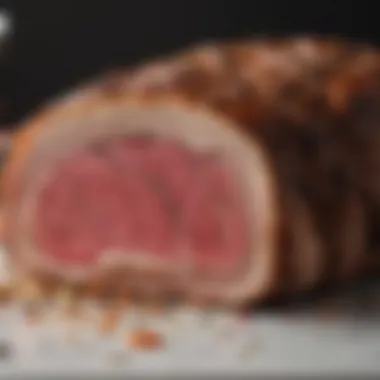
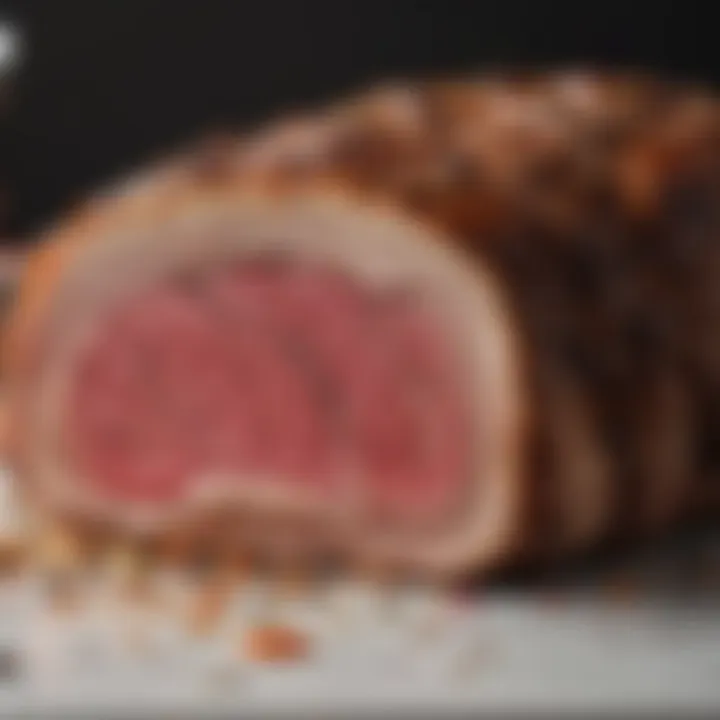
With the rise of e-commerce, sourcing prime rib online is becoming more popular. Many online meat retailers offer a wide variety of cuts. They can process orders and deliver directly to your door, saving you time and effort. Other benefits include the opportunity to access gourmet options that might not be available locally.
Benefits of Online Shopping
The primary advantage of online shopping is convenience. You can browse selections at any time, compare prices, and read customer reviews. This all helps foster an educated purchasing decision. Another key characteristic worth noting is the extensive variety that online platforms can offer.
Online retailers often source their meat directly from farms, providing you with unique and sometimes premium options. This can significantly enhance the quality of your prime rib. A unique feature of this avenue is storage and freshness capabilities due to advanced packaging methods, extending the meat's lifespan and preservation upon arrival.
Considerations for Shipping and Handling
When purchasing online, shipping considerations are critical. Prime rib is a perishable item, so properly managing temperature during transit is essential. High-quality retailers use specialized packaging to hkeep the meat cold.
While ordering online can save time, the shipping fees might offset the overall cost, depending on the source. It’s also advisable to check return policies in case the product does not meet your expectations or arrives damaged.
Understanding these elements is important in mitigating risk. Ultimately, being attentive to sourcing options remains vital in enjoying a fantastic prime rib experience.
Understanding Pricing
Understanding the pricing of a prime rib roast is an essential aspect for anyone keen on purchasing this esteemed cut of meat. A clear understanding of pricing not only helps in budgeting but also informs about quality and value. It can determine where to buy, which type to select, and even whether it's the right time to make such a purchase. In this section, we will explore the various factors that influence the cost and also identify the best places to find prime rib at competitive prices.
Factors Influencing Cost
Quality and Grading
Quality and grading significantly influence the price of prime rib. The USDA grading system assigns ratings such as prime, choice, and select to beef. Prime, the top tier, offers superior marbling, tenderness, and flavor, which understandably comes at a higher price. Selection of high-grade prime rib is considered a valuable choice for connoisseurs. However, while opting for lower grades like choice does save some cost, it may not provide the same uplift in culinary experience.
The unique attribute of grading lies in marbling, which visually refers to the small flecks of fat within the meat. This fat contributes directly to flavor and juiciness while cooking. While the higher grade costs more, many find it worth the investment for occasions or celebrations. One potential downside is availability. Occasionally prime rib in the highest grade can be harder to leave as the market prefers leaner cuts.
Market Demand
Market demand plays a central role in determining prime rib prices. Factors such as holiday seasons, celebrations or even special events tend to inflate prices, reflecting the readiness of consumers to pay more during high-demand periods. This cycle is beneficial as it indicates grain stability for prices. Burgers and other cuts tend to take the spotlight, but promotions may spring to life in nonpeak times.
When analyzing current demand trends, it can also emphasize consumer behavior about what is considered gourmet versus routine in offerings. Such insights lead businesses to adjust pricing accordingly. For those looking to save potential costs, timing your purchase will prove prudent. More settled pricing may reflect quarterly viability diminishing wider price variability.
Where to Find Best Deals
Finding the best deals on prime rib is necessary if you want to ensure that your culinary ambitions align with your financial plans. Here are a few suggestions to consider:
- Local Butchers: Cultural connections often shape personal cuts which result in diverse preferences seen at local levels. Visiting local butcher shops can ensure personalized service and possibly lower prices.
- Grocery Stores: Look for promotions or discounts, especially during holidays.
- Online Retailers: Websites like meatmarket.com or butcherbox.com can offer costs-saving deals, but it’s important to consider shipping expenses.
Try to stay informed and shop accordingly to ensure effective budgeting for your prime rib roast. Following trends and timings can make a pronounced difference in how much remains in your pocket after your purchase.
Preparing for Cooking
Preparing for the cooking process is a critical phase in achieving an excellently prepared prime rib roast. Each aspect involved in this preparation period impacts the final result, influencing flavor, tenderness, and overall enjoyment. Understanding and meticulously handling this phase transcends mere cooking; it engages in the art and science of culinary excellence.
Essential Tools and Equipment
To initiate your prime rib journey, having the proper tools is essential. The route to vivid and hearty results relies on these tools working efficiently. The essentials include:
- Sharp Knife: A good sharp knife facilitates precise cuts.
- Chopping Board: A durable surface is crucial for prepping meats.
- Meat Thermometer: This ensures an accurate measure of doneness, which is key to results.
- Roasting Pan: A well-sized pan distributes heat evenly, improving cooking consistency. By possessing these essential tools, you strongly set the grounds for an optimal cooking process.
Marinades and Seasonings
Marinating and seasoning a prime rib roast enhances its flavor profile. This development is impactful and can elevate a good roast to magnificent. Some common choices for marinades include:
- Olive Oil and Garlic: Adds rich depth and aroma.
- Red Wine: Introduces acidity which can balance flavors beautifully. Using quality freshly ground herbs such as thyme and rosemary during the rub is recommended. The application should ideally begin the day before, allowing time for flavors to infuse.
Resting and Trimming Techniques
The resting process after cooking can amplify tenderness significantly. This is so because meat fibers tighten during cooking, but by allowing it to rest, the juices redistribute evenly and enhance overall moisture. A general rule of thumb is to let the roast rest between 15 to 30 minutes before carving.
Additionally, trimming excess fat is vital to avoid greasiness and can improve cooking. Care should be given to ensure that not all fat is trimmed away; the fat acts as a moisture retainer, yielding an enjoyable and luxurious mouthfeel.
Tip: Always consider retaining a thin layer of fat on the roast for moisture, but excessive layering needs moderation.
Each preparation step cultivates the foundation that culminates in a succulent prime rib roast, rich in flavor and inviting softness.
Cooking Methods
Understanding different cooking methods for prime rib can significantly enhance your culinary experience. Each method helps achieve distinct flavors and textures, which can make or break the final dish. By exploring these methods, home cooks can select the approach that best suits their taste preferences and capabilities.
Roasting
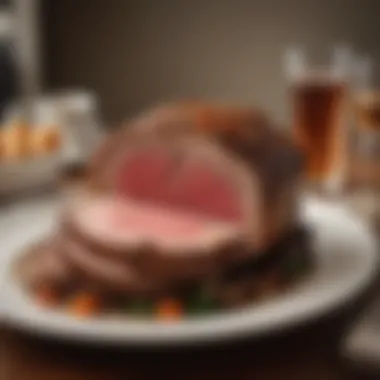
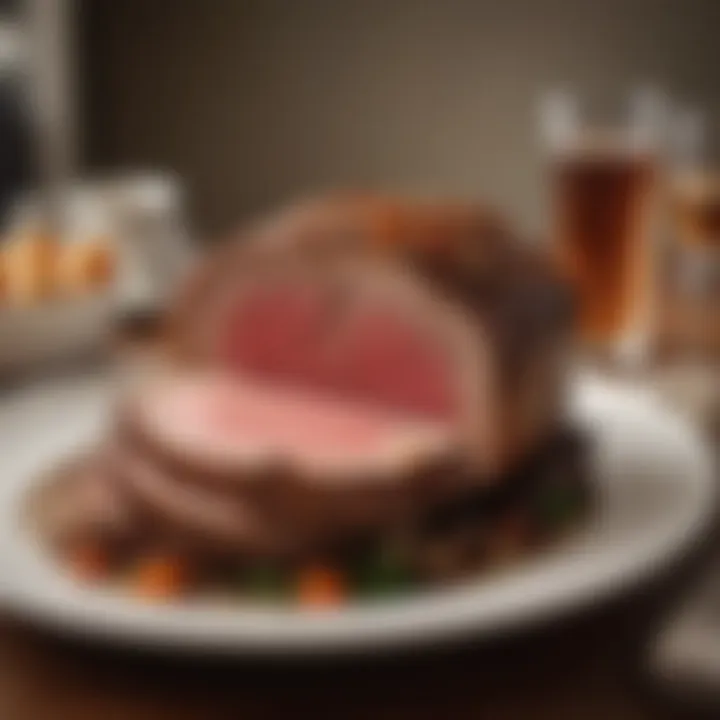
Roasting remains one of the most preferred techniques for cooking prime rib. It allows the meat to develop a rich flavor and tender texture when done correctly. Two specific aspects are essential in this cooking method: Temperature Guidelines and Cooking Time Calculations.
Temperature Guidelines
Cooking a prime rib roast properly requires adherence to established temperature guidelines. The center of the roast should reach desired doneness, typically ranging from about 130°F for medium-rare to 160°F for well done. This precision contributes to texture and flavor, providing a consistent eating experience. The benefit of observing these guidelines is the ability to enjoy a juicy, tender beef roast. A sharply rendered crust on the outside contrasts effectively with the beautifully cooked interior.
However, it’s important to adjust expectations based on the size of the cut. Larger roasts may need slightly more time before they achieve those ideal internal temperatures. A notable disadvantage of this method is the potential for overcooking, especially when standard procedures are not adequately followed. Trusting a meat thermometer is paramount.
Cooking Time Calculations
Cooking time must be calculated based on the weight of the prime rib roast. Measuring accurately affects how well the roast turns out. Generally, a roast needs about 15 to 20 minutes per pound at a temperature of 325°F. Knowing this guideline can help precision at the dinner table.
One unique feature of calculating cooking time is the possibility of resting the meat post-cook. It is crucial as it allows the juices to redistribute, sounding perfect for slicing once you are seated at the table. While applying general times gives a sense of predictability, remember that variations in cookware and meat preparations could alter results slightly.
Grilling
Grilling is another method that can impart smokier notes to prime rib. When done properly, it offers a charred crust combined with the roast's epic tender center. It’s important to monitor heat settings to avoid drying out the meat. This technique also permits the use of marinades and herb mixes, amplifying its taste. Careful attention to heat management can lead to excellent outcomes, but failure in this could detract from the overall flavor.
Sous Vide Technique
Sous Vide offers a distinct approach to cooking prime rib. The essence of Sous Vide lies in sealing the meat in plastic and cooking it in temperature-controlled water. This precise method deeply impacts tenderness by allowing the roast to cook uniformly.
Benefits of Sous Vide
The method’s key characteristic is its precision. It guarantees achieving the desired internal temperature throughout the heat process. This approach helps minimize overcooking while keeping lean cuts from excessive moisture loss. For prime rib enthusiasts, it amplifies the meaty flavor without compromising juiciness. However, it does have a significant drawback; preparing this way can take a longer time, requiring an initial commitment.
Setup and Cooking Process
Setting up for Sous Vide includes preparing the water bath and ensuring consistent temperatures. A good immersion circulator will lead you through a more predictable cooking experience. It’s considered a beneficial choice because it results in high quality and repeatable consistency. The challenge arises with the necessary planning. Your cooking times could easily exceed other methods amplifying the need for patience in your cooking approach.
Using different cooking techniques not only influences the taste of prime rib but challenges the enrichment of overall culinary methods embraced by food enthusiasts.
Serving Suggestions
Serving suggestions are a critical aspect of enjoying a prime rib roast. They not only elevate the dining experience but also allow individuals to pair flavors that complement the richness of the meat. Understanding how to serve prime rib appropriately adds sophistication to any meal while ensuring that every element of the dish harmonizes well.
Garnishes and Accompaniments
When it comes to garnishes and accompaniments, the goal is to enhance rather than overwhelm the primary dish. Fresh herbs, like rosemary or thyme, can provide aromatic lift to the robust flavors of a prime rib roast. For texture and contrast, horseradish sauce is a well-known favorite. Its heat cuts through the fat of the meat, providing a refreshing balance.
Here are a few common garnishes to consider:
- Herb butter: A rich but fresh option that’s easy to prepare. By mixing softened butter with minced herbs and garlic, you'll create a flavorful topping that melts onto the warm meat.
- Caramelized onions: They provide sweet depth, making the roast even more satisfying. You can easily add these alongside the meat while it rests.
- Gravy: Homemade gravy using the drippings from the roast is both traditional and delightful. It can add moisture and add flavor to even the driest parts of the meat.
These garnishes will not only beautify the presentation of your prime rib roast but will also steady the palate's change while dining.
Ideal Side Dishes
Choosing the right side dishes is fundamental to creating a balanced meal around prime rib roast. Each side should complement the richness of the meat while offering variety in texture and flavor. As prime rib can be quite heavy, selecting lighter and fresh sides is important to keep the meal enjoyable.
Consider some of these side dishes:
- Roasted vegetables: Carrots, Brussels sprouts, or squash roasted with olive oil and seasoning create a caramelized sweetness that works very well.
- Mashed potatoes: Creamy potatoes packed with butter can absorb flavors from the meat while providing a decadent element to the overall plate.
- Caesar salad: A crisp Caesar salad with dressings creates a refreshing counterpoint. The crunch of romaine or kale adds texture.
- Yorkshire pudding: This traditional accompaniment offers a practical approach to enjoying any leftover roast juices or borders on a unique dessert experience.
By carefully selecting complementary side dishes, you can curate meals that create a memorable dining experience centered around prime rib roast. These serving suggestions not only showcase the roast but also demonstrate how diverse and rich the culinary experience can be.
Storing Leftovers
Leftovers from a prime rib roast can be a culinary treasure if stored correctly. Many people overlook the aftermath of a large cooking endeavor, yet how one manages these leftover portions can greatly enhance future meals and minimize waste. Improper storage often leads to the trial of spoiled meat, losing both flavor and texture. Therefore, understanding proper storage techniques is essential for achieving delicious meals down the line while maximizing yield from your prime rib roast.
Proper Storage Techniques
To effectively store your prime rib leftovers, begin by allowing the meat to cool at room temperature for no more than two hours. Protecting the quality and preventing bacteria growth is important. Once cooled, consider the following practices:
- Wrap Tightly: Use plastic wrap or aluminum foil to tightly enclose the meat. A vacuum seal can preserve freshness longest. If using a container, ensure it is airtight.
- Portioning: Divide the prime rib into meal-sized portions for easy reheating. This approach also reduces waste on non-eaten portions, counteracting the temptation to grab larger amounts while heating.
- Label and Date: It helps to indicate the content and date of storage. Prime rib can generally last safely in the refrigerator for up to four days. Labeling clarifies which item was stored and assists in prioritizing meal planning.
By implementing these processes, the overall experience of consuming leftovers turns convenient and appealing.
Reheating Methods
The key aspect of enjoying leftover prime rib involves the reheating process. Proper reheating not only brings out the leftover flavor, but it also helps maintain texture. Regrettably, heating it wrong may lead to tough or dry meat. Here are some effective reheating methods:
- Oven Reheating: Preheat the oven to 250°F. Place the rib roast or sliced meat on a roasting pan with a bit of broth or water. Tent it loosely with foil to traps in moisture. This allows thorough heating without overcooking.
- Microwave: If time is a concern, using microwave can expedite reheating. Place the meat on a microwave-safe plate, add a splash of broth, cover it with a microwave-safe lid, and nuke it for short intervals until warm, turning can help promote even heating.
- Sous Vide Technique: Reheating with a sous vide machine keeps prime rib moist and tender. Seal the meat in a plastic bag and place it in a water bath, maintaining a steady temperature of around 130°F for about 30 minutes or until warmed transfer to a hot grill or skillet sear quickly to regain a crispy exterior before serving.
Most importantly, abstain from overcooking. Maintaining the inner juiciness is key to not sacrificing the quality in behalf of efficiency. Prioritize practicing these stocking and reheating techniques to enrich your prime rib experience beyond its initial serving.







